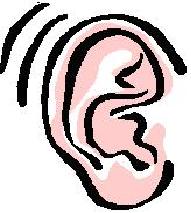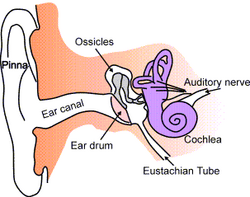How does music get from an instrument,
radio, or voice into our consciousness? The brain can detect harmony
because the inner ear can tell the difference between different frequencies.
What this implies is that the brain's ability to differentiate between
notes and chords relates to the differences in frequency and harmonics,
while our "sense" of music is more of an enculturation from observation
of accepted harmonies through time. The ear is the objective listener;
the brain decides whether the music sounds beautiful or not, which tends
to be more subjective.



The human's ability to hear sounds comes from the anatomy of the inner ear and the brain, and of course, whatever is out there causing a ruckus. Sound is a combination of the mechanical energy of waves and the electric response produced by receptors in the brain. Each sound wave has an amplitude and a frequency (ƒ = 1/T, ƒ is the frequency; T is the period). The amplitude of a vibration is defined by volume using decibels. Frequency relates to differences in pitch. The higher the frequency, the higher the pitch. Mathematically, pitch (another name for "note") is defined as the number of vibrations per second.

http://en.wikipedia.org/wiki/Amplitude
Amplitude is a component of sound, along with frequency.
In vertebrates, once sound waves penetrate the outer ear, they hit the ear drum which sends the message to the cochlea (fancy name for inner ear) where the sound is changed into chemical energy. The cochlea has fluid in it along with stereocilia (fancy name for tiny little hairs). Sound waves travel through this fluid, and stimulate the stereocilia which prompts the release of K+ (potassium). Some ion channels open up so the potassium can move freely into cells. Next, neurotransmitter release is dependent on the frequency and amplitude (pitch and volume) of the sound waves. Sounds must be loud enough and within a specific range of frequencies in order to cause action potentials, depending on the vertebrate. For example, dolphins create such high frequency sounds and whales such low frequency sounds that human ears rae not able to process them. Different sounds create different action potentials, which allows harmony to be discerned at the neural level. Each of the stereocilia can best hear one frequency, and each stereocilia is different - that is how many notes can be processed at the same time in order to hear harmony. Cool!

http://en.wikipedia.org/wiki/Ear
A map of the ear (the stereocilia are inside the cochlea)
Once the pitch and volume have been changed into action potentials, the sound travels along inner ear through the auditory nerve, all over the brain, and at last to "the auditory cortex of the temporal lobe" (the hearing department of the brain). From there, memory can come into play along with emotion which leads to self-expression and so many other wonderful things!
(All images from
Microsoft XP Clip Art)
Sound is made
The sound waves enter
the ear
The brain eventually processes the
sounds
The human's ability to hear sounds comes from the anatomy of the inner ear and the brain, and of course, whatever is out there causing a ruckus. Sound is a combination of the mechanical energy of waves and the electric response produced by receptors in the brain. Each sound wave has an amplitude and a frequency (ƒ = 1/T, ƒ is the frequency; T is the period). The amplitude of a vibration is defined by volume using decibels. Frequency relates to differences in pitch. The higher the frequency, the higher the pitch. Mathematically, pitch (another name for "note") is defined as the number of vibrations per second.

http://en.wikipedia.org/wiki/Amplitude
Amplitude is a component of sound, along with frequency.
In vertebrates, once sound waves penetrate the outer ear, they hit the ear drum which sends the message to the cochlea (fancy name for inner ear) where the sound is changed into chemical energy. The cochlea has fluid in it along with stereocilia (fancy name for tiny little hairs). Sound waves travel through this fluid, and stimulate the stereocilia which prompts the release of K+ (potassium). Some ion channels open up so the potassium can move freely into cells. Next, neurotransmitter release is dependent on the frequency and amplitude (pitch and volume) of the sound waves. Sounds must be loud enough and within a specific range of frequencies in order to cause action potentials, depending on the vertebrate. For example, dolphins create such high frequency sounds and whales such low frequency sounds that human ears rae not able to process them. Different sounds create different action potentials, which allows harmony to be discerned at the neural level. Each of the stereocilia can best hear one frequency, and each stereocilia is different - that is how many notes can be processed at the same time in order to hear harmony. Cool!

http://en.wikipedia.org/wiki/Ear
A map of the ear (the stereocilia are inside the cochlea)
Once the pitch and volume have been changed into action potentials, the sound travels along inner ear through the auditory nerve, all over the brain, and at last to "the auditory cortex of the temporal lobe" (the hearing department of the brain). From there, memory can come into play along with emotion which leads to self-expression and so many other wonderful things!
HOME HARMONY SOUND BIBLIOGRAPHY